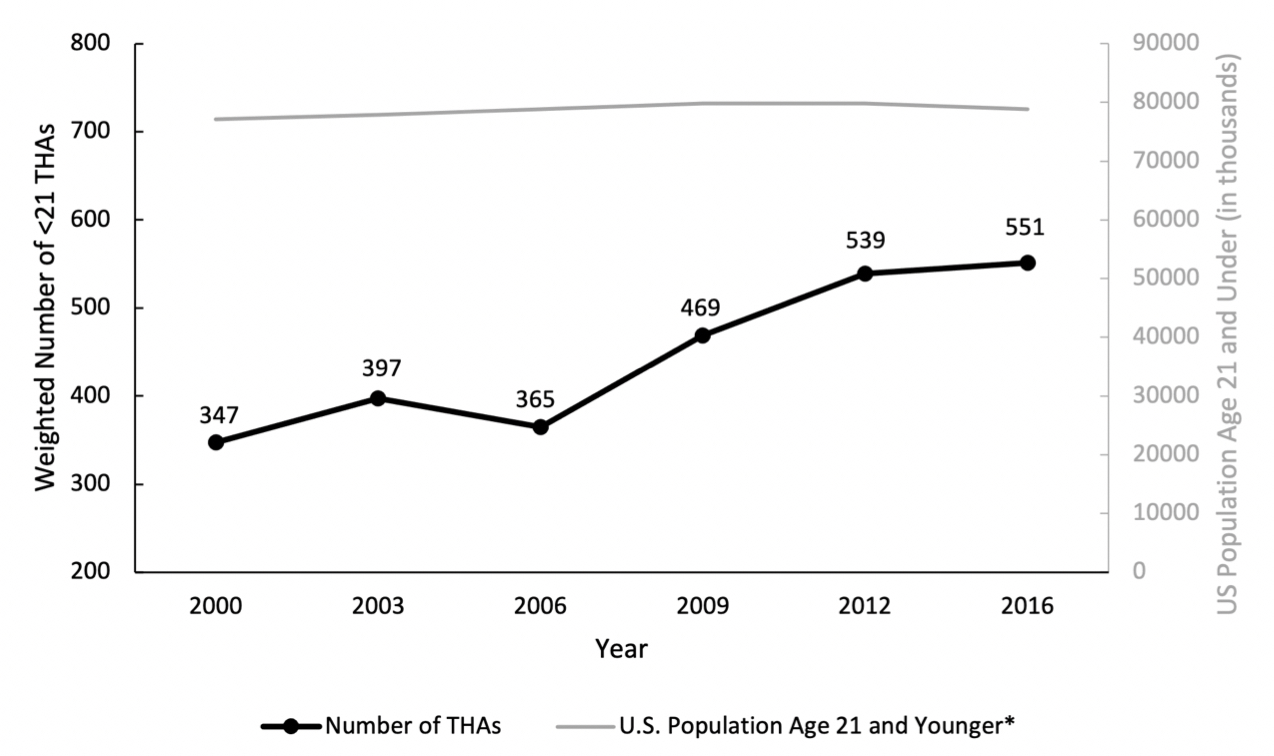Session Information
Date: Tuesday, November 9, 2021
Title: Pediatric Rheumatology – Clinical Poster III: Miscellaneous Rheumatic Disease (1614–1644)
Session Type: Poster Session D
Session Time: 8:30AM-10:30AM
Background/Purpose: Total hip arthroplasty (THA) is a treatment option for young patients with severe hip pathology due to congenital, developmental, rheumatologic, traumatic, and other acquired conditions. However, the frequency with which THA is used to treat patients in this population in the United States is unknown. Knowledge of the epidemiology of use of THA in this population may help to guide health policy and future research into the indications, outcomes, and failure modes of THA in very young patients. Therefore, the purpose of this study was to evaluate the use of THA in patients under 21 years of age in the United States.
Methods: We retrospectively reviewed the Kids’ Inpatient Database (KID), an inpatient US national database of hospital admissions in patients under 21 years of age from approximately 4,200 hospitals in 46 states. We queried the database using current procedural terminology (CPT) codes for elective and non-elective primary THA from 2000-2016. Descriptive statistics such as means and percentages, along with their 95% confidence intervals were calculated using the appropriate sample weights as recommend by the Agency for Healthcare Research and Quality (AHRQ) for use with the KID dataset. Discharge weights were used for nationwide estimates.
Results: The weighted total number of THAs performed in patients under 21 in the KID increased from 347 in 2000 to 551 in 2016, while the total pediatric population in the US remained stable (Figure 1). The mean age of patients under 21 undergoing THA was 17.1 years (95% confidence interval: [16.9, 17.4]) (Table 1). The mean age remained consistent (between 17.0 and 17.4) throughout the course of the study. Most patients were white (55.3%) and had private insurance (56.5%). During the study period, 80% of THAs were performed in urban teaching hospitals, 17% were performed in urban non-teaching hospitals, and 2% were performed in rural hospitals. The most common diagnoses were osteonecrosis, osteoarthritis, and juvenile idiopathic arthritis (JIA)/inflammatory arthritis. During the study period (2000-2016), the frequency of THA for osteonecrosis increased from 24% to 38%, while the frequency of THA for JIA/inflammatory arthritis decreased from 27% to 4% (Figure 2).
Conclusion: The number of THAs in patients under 21 has increased over the past two decades and these procedures are increasingly performed in urban teaching hospitals. The decrease in THA for inflammatory arthritis in this population likely reflects improvements in medical management during the study period. Knowledge of the epidemiology of use of THA in this population may help to guide health policy and future research into the indications, outcomes, and failure modes of THA in very young patients.
 Table 1. Demographic characteristics of patients < 21 who underwent THA
Table 1. Demographic characteristics of patients < 21 who underwent THA
 Figure 1. Weighted Total Number of THAs in Patients < 21 per year *U.S. population estimates from National Center for Education Statistics. Table 100.10. Estimates of resident population, by age group: 1970 through 2019. https://nces.ed.gov/programs/digest/d19/tables/dt19_101.10.asp (Accessed 12 May 2021).
Figure 1. Weighted Total Number of THAs in Patients < 21 per year *U.S. population estimates from National Center for Education Statistics. Table 100.10. Estimates of resident population, by age group: 1970 through 2019. https://nces.ed.gov/programs/digest/d19/tables/dt19_101.10.asp (Accessed 12 May 2021).
 Figure 2. Changes in Frequencies of Most Common Diagnoses
Figure 2. Changes in Frequencies of Most Common Diagnoses
To cite this abstract in AMA style:
Gibbons J, Kahlenberg C, Jannat-Khah D, Goodman S, Mandl L, Sculco P, Goodman S, Figgie M, Mehta B. Use of Total Hip Arthroplasty in Patients Under 21 Years Old: A U.S. Population Analysis [abstract]. Arthritis Rheumatol. 2021; 73 (suppl 9). https://acrabstracts.org/abstract/use-of-total-hip-arthroplasty-in-patients-under-21-years-old-a-u-s-population-analysis/. Accessed .« Back to ACR Convergence 2021
ACR Meeting Abstracts - https://acrabstracts.org/abstract/use-of-total-hip-arthroplasty-in-patients-under-21-years-old-a-u-s-population-analysis/
